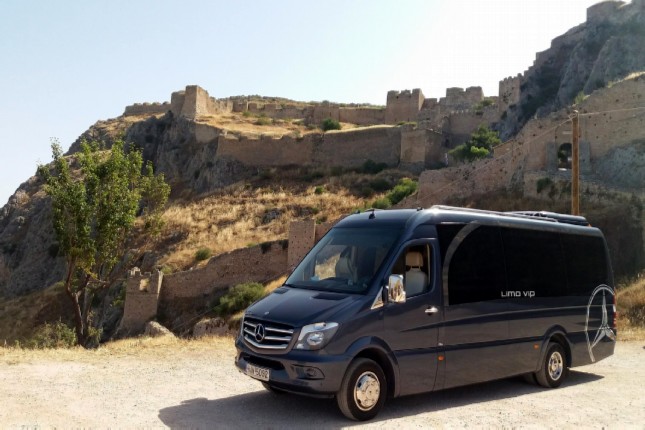The Peloponnese is not only home to numerous monuments and historical - archaeological sites but also legendary castles, fortresses, and castle-towns. Unearth the myths and tales of battles and chivalry spread throughout the Peloponnese. These destinations are perfect for a family holiday all year round. Derived from fairy tales, built by giants and irrigated by thousands of years of history, the legendary castles of the Peloponnese offer mystical journeys and magnificent views.
Acrocorinth Castle - The Overseer of the Peloponnese
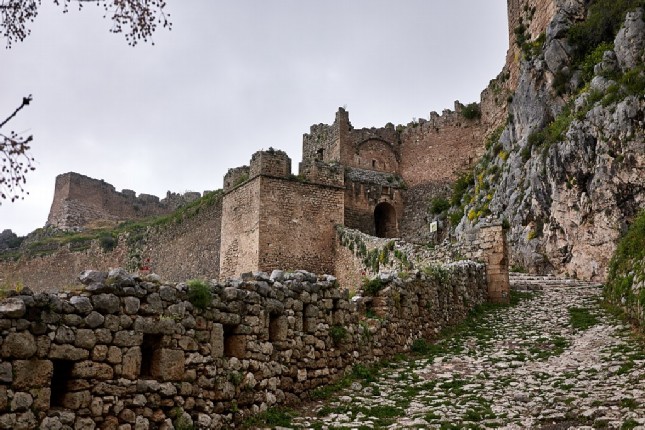
At the "entrance" of the Peloponnese, a low but steep rock has been the city's guardian for centuries. On top of it stands one of the most well-preserved ancient castles. Follow the path that leads to the impressive entrance with the triple gates.
The Acrocorinthian castle is the largest castle of Morea, which has functioned since antiquity as "the overseer of the Peloponnese". The castle includes a large courtyard and is a typical example of fortress architecture. The walls follow a polygonal path, in line with the rock's natural curve, and are occasionally reinforced by towers and bastions. At the highest part of the rock, there are only a few ruins that resemble the temple of the Patron Goddess of Corinth, Aphrodite and her 1000 priestess. On these ruins, a Christian basilica was built. The view from the Acrocorinth will take your breath away. In front of you lies the whole of the Corinthian land, up to the borders of Argolis and opposite Central Greece, over Mount Geraneia and up to the borders of Achaea.
The fortification of ancient Corinth consists of three parts: The Acropolis, the Acrocorinth, at the northern foothills of which the ancient city is located; the long walls that connected the city wall with the city and the port of Lechaion.
Inside the castle, the temple of Aphrodite, the small temples dedicated to the goddess Demeter and her daughter Persephone, the altars of Helio, the fountain of "Upper Pirene" among others, have come to light. Because the castle has been in constant use from early antiquity, buildings have been demolished and rebuilt several times, while building material has been used to meet the needs of the times.
Palamidi - The Guard of History
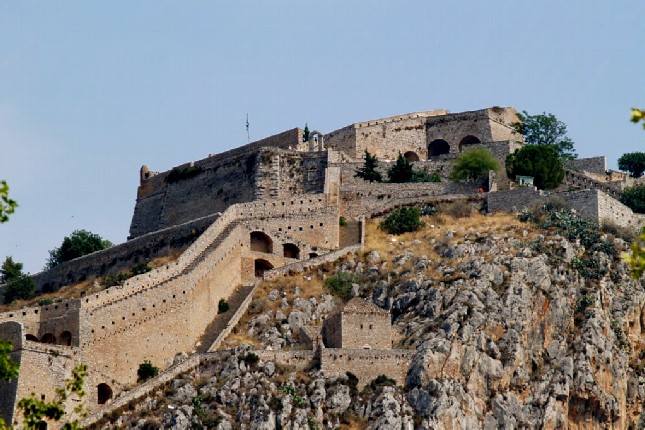
The Palamidi fortress is located east of the city of Nafplio on a hill of 216 meters. It was named after the mythical hero of the Trojan War, Palamides, son of Nafplio. A guard of the whole of modern history, Palamidi stands out for its Venetian fortification architecture, which follows the natural curve of the hill, so that it blends harmoniously over it. It was built and fortified during the Second period of the Venetian occupation (1686-1715), according to designs by Giaxich and Lasalle. It is a typical baroque fortress and consists of 8 independent bastions. Each of them can be used for defense or attack. The central bastion was St. Andreas, which, because of its location, was used as a Garrison.
In 1715, it was occupied by the Turks. But in November 1822 the castle passed into the hands of the Greeks. After the Revolution of 1821 and until about 1925, prisons operated inside the building. Theodoros Kolokotronis was also imprisoned here. Inside the fortress, beyond the cell of Kolokotronis, you will see the chapel of St. Andreas and the relief Lion of St. Mark, the coat of arms and emblem of Venice. It is accessible by road and by its famous 999 steps. Whichever way you choose, you will be rewarded by the view that stretches out in front of you.
Bourtzi - The Island – Fortress
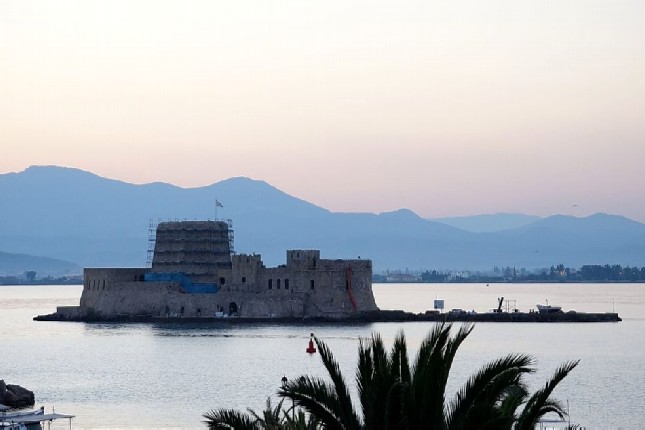
At the entrance of the port of Nafplio, about 450 meters from the mainland, stands Bourtzi, a fortress - the trademark of the city, built on the islet of Agioi Theodoroi, where the homonymous Byzantine temple existed.
Bourtzi in Turkish-Arabic means "tower" and the small fortress was built in 1473 by the Venetians, who took advantage of the geographical location of the island and built a cannon tower. The design was undertaken by the Italian architect Antonio Gambello. However, fortifications were also made during the Second Venetian domination, after its occupation by Morosini (1686), when the castle took its present form.
The fortress follows the shape of the islet. In the center stands a tall irregular hexagon tower and is framed by low semicircular towers with cannons to its east and west sides. A small bay has been formed on the northeast side of the island to make access easier.
Bourtzi functioned as a fortress until 1865. Then, at the behest of King George I, the executioners of Palamidi's prisons settled in the area. In the 1930s it was a center of the Tourism Organization and later functioned as a luxury hotel.
Today it is one of the main attractions of the city. It welcomes visitors daily, arriving by boat from the opposite mole, which runs throughout the day.
Patras Castle and the Weeping Ghost of Patrinella
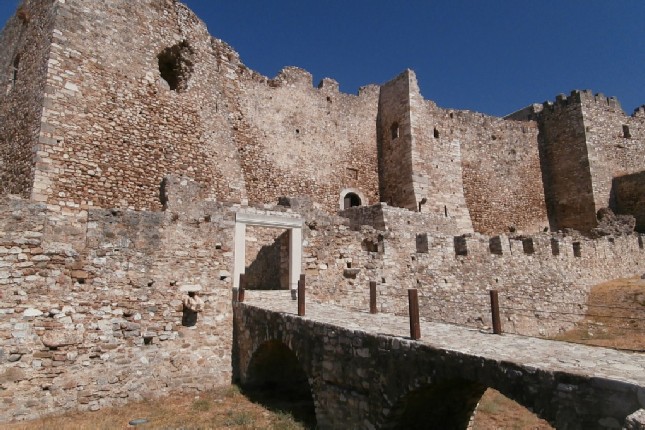
One of the many attractions that adorn the city of Patras and is a landmark is the imposing Castle. The Castle of Patras is built on a low hill of the Panachaiko Mountain, 800 meters from the coast.
It was built by Byzantine emperor Justinian I around 551 AD for the defense of the area and its inhabitants on the ruins of the acropolis of the ancient city of Aroi. In ancient times, the center of the city was the Acropolis which stood in the place of today's Castle. The castle was built mainly with building material from the site’s ruined buildings. The castle, as we see it today, was built in medieval times and consists of a wide, almost triangular outer enclosure with towers and bastions, surrounded on three sides by a deep moat. It witnessed wars, riots, and powerful earthquakes and managed to stand and adorn the capital of Achaea. It impresses all year round and especially in the spring when it is covered in flowers thus forming a magical image.
Interestingly enough, the Castle of Patras is also known for the mysterious statue of "Patrinella". According to popular tradition, Patrinella was a woman who was transformed into a man during the Turkish occupation. Patrinella occupied the south-eastern tower of the castle and guarded the city against epidemics. She now goes out into the streets of the city at midnight dragging chains and weeps whenever a prominent citizen of Patras dies.
Chlemoutsi Castle – The Stronghold of the Knights-Crusaders
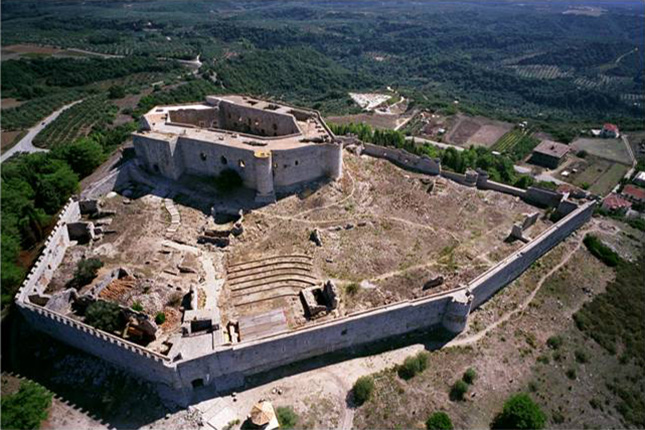
The beautiful medieval castle of Chlemoutsi stands on the summit of Halonata hill on the westernmost headland of the Peloponnese and is considered one of the most important and best-preserved castles in Greece. It was built between 1220 and 1223 by the Crusaders during the rule of the Prince of Achaea Geoffrey I of Villehardouin and was the strongest fortress in the Frankish Principality of Achaea.
The castle’s strategic location protected the largest port and town, Glarentza (now Kyllini), and the capital of the Principality, Andravida, and controlled the area that formed the core of the Frankish possessions in the Morea. The name "Morea" is a corruption of the word morus or mulberry. This was the name given to the Peloponnese in medieval times because there were so many mulberry trees. These three sites were the administrative heart of the Principality and, along with the fortress of Beauvoir or Pontiko at Katakolon, served to secure control of the plain of Elis.
The castle consists of two enclosures: the outer polygonal Enclosure and the Interior Enclosure. Access to the core of the castle, where the princely palace was located, was via gate which led into the central inner courtyard through a vaulted passage. Marvel at the stone catapult projectiles which once defended the castle. Huge cisterns under the ground were used for collecting rainwater in times of siege since there was no well. The complex consists of 6 wings, 5 of which are two-storey.
The workshops, storerooms, staffrooms, and stables were on the ground floor. The upper floor was the princely residence. There were private apartments, bedrooms, kitchens, and the chapel. The princess’s bedroom has now been converted into a museum. The bedroom of the princess has a beautiful fireplace, the first in Greece, two large light-windows with seats and even built-in cupboards.
From the main square of the nearby picturesque village of Kastro (which means “castle” in Greek), it is about 5 minutes on foot or a few minutes by car up the hill.
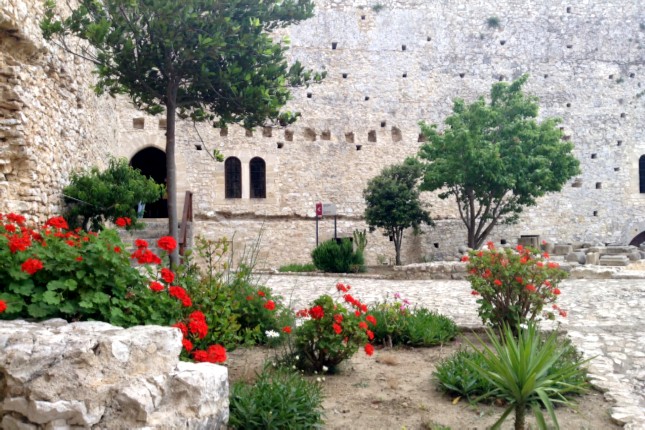
Travel to the world of knights and crusaders and uncover unknown aspects of the Medieval world. Join the Travel Insiders on a journey to the legendary castles of the Peloponnese:
- Nafplio on Foot & Palamidi Fortress - A Walking Tour (3-4h)
- Nafplio with a Visit to Ancient Mycenae (4h)
- Nafplio - Mycenae - Epidauros & Photo Stop at Corinth Canal (8h)
- The Highlights of Nafplio - Ancient Mycenae & the Epidauros Theater (6h)
- Achaia Clauss Winery & Church of Agios Andreas in Patras (full day)
- Chlemoutsi Castle & Kourouta Beach Getaway - Kid Friendly Tour (full day)

